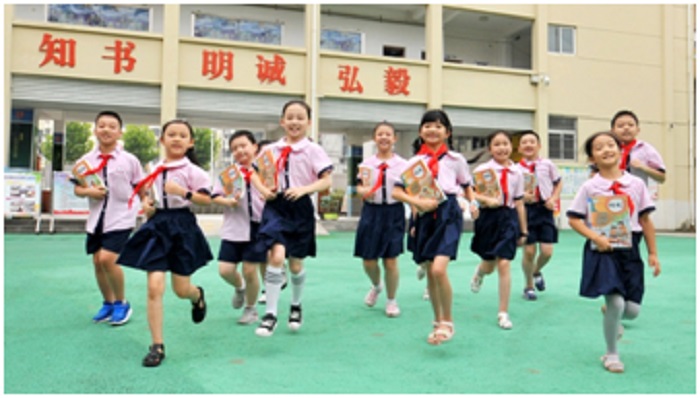



Students from kindergartens, primary and secondary schools in 30 Chinese provinces, municipalities and autonomous regions returned to school on Sept. 1, the usual starting time of the autumn semester in China.
Universities in the country have also welcomed students back in batches according to their grades and regions since late August.
Science-based planning and deployment of the resumption of school, as well as epidemic prevention in autumn and winter remain the most important missions of China’s education department, said an official from the country’s Ministry of Education (MOE) at a press conference held on Aug. 27.
According to the official, the MOE required that the new semester to be started in a secure, normal and comprehensive manner.
The returning to school of nearly 300 million students and faculty members, especially the over 10 million college students who traveled across cities and provinces, has posed a larger challenge to COVID-19 prevention and raised the risk of virus spread, said Wang Dengfeng, an official with the MOE.
The increasing risk of COVID-19 infection from abroad, as well as the possible relict infection sources are still maintaining the risk of resurgence, Wang said, adding that the autumn and winter, as seasons that see frequent occurrences of respiratory infectious diseases, would also increase the difficulty of discovering, identifying and diagnosing COVID-19.
He stressed the importance of improving emergency plans and drills, saying cases shall be quarantined and reported at the first opportunity once discovered to minimize the impact. The MOE will also guide local authorities and schools to practice recommendable health habits and lifestyles, such as social distancing, frequent hand washing and using serving chopsticks, he added.
Online education played an important role in maintaining students’ learning activities during the suspension of classes. According to Lyu Yugang, director of the MOE’s Department of Basic Education, the ministry has developed 4,000 online classes for all grades and courses of primary and secondary schools in the autumn semester, and will launch various quality video courses on the national cloud education platform and China Education Network Television (CEN TV).
So far, the MOE has selected 90 districts to pilot the integrated online-offline education. Besides, the ministry, together with the CEN TV, also equipped nearly 12,000 classrooms in 52 impoverished counties with satellite signal receiving devices, so that the students in these regions will be able to access the classes by outstanding teachers from Beijing through TV broadcast.
Wu Yan, director of the Higher Education Department under the MOE, introduced that all colleges and universities in China had adopted online classes during COVID-19 response. Over 1 million Chinese teachers have provided about 1.1 million online courses, attracting nearly 22.6 million university students.
Big data suggested that 91 percent of college courses were available online, and the performance of 80 percent of the teachers was recognized. Eighty-five percent of the students said they were satisfied with online education.
A survey conducted by the MOE in June, which was participated by 14,532 correspondents from 9 provinces, indicated the rate of myopia among Chinese primary and middle school students increased by 11.7 percent in the first six months of the year from the end of 2019. The growths stood at 15.2 percent, 8.2 percent, and 3.8 percent, respectively, for primary students, middle school students and high school students. Around 45.8 percent of the students who spent 1 hour on online classes were myopic, while the figures were respectively 49.3 percent, 62.4 percent and 76.7 percent among those spent 1 to 2.5 hours, 2.5 to 4 hours, and over 4 hours on online courses.
Besides, the MOE also conducted a research on how non-study video watching was impacting the eye health of the students. It found that the myopia rates of students were respectively 50 percent, 58 percent, 63 percent and 73 percent for the above four categories.
Wang said that the time spent on online courses shall be less than 2 hours for primary students, 3 hours for middle school students, and 4 hours for high school students. The students are also requested to join at least one hour of outdoor activities and sports every day.
According to a plan jointly made by the MOE, the National Health Commission and other seven departments, myopia prevention, myopia rate and physical health of adolescents shall be incorporated into the performance appraisal for local governments. Adolescents’ mental and physical health, as well as academic burden shall be incorporated into the monitor and assessment system for national compulsory education.


The Humanitarian Service Diamond Awards has.
A Chinese Company, Inner Galaxy Steel.


The Programme Coordinator, Regulatory, Compliance and.


A Non-Governmental Organization (NGO), Committee for.
The Trustfund Pensions Limited has chided.


The House of Representatives Committee on.
The China General Chamber of Commerce.


Senator Chuka Utazi who represented Enugu.


An Abuja based Legal Practitioner, Ugochukwu.


The African business community in Yiwu,.
Leave a Comment